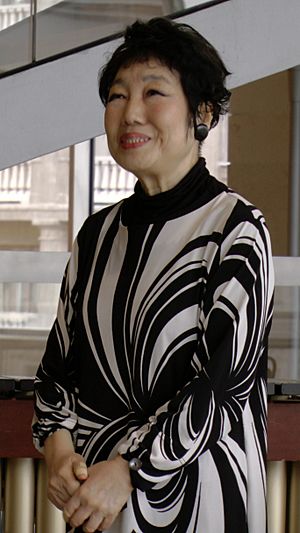Keiko Abe facts for kids
Quick facts for kids
Keiko Abe
|
|
|---|---|
 |
|
| Background information | |
| Native name |
安倍 圭子
|
| Born | April 18, 1937 Tokyo, Japan |
| Instruments | Marimba |
Keiko Abe (born April 18, 1937) is a famous Japanese musician. She is a talented composer and a master of the marimba. Keiko Abe helped make the marimba what it is today. She worked with the Yamaha Corporation to create the modern five-octave concert marimba. This instrument is now used by many musicians around the world.
Contents
Keiko Abe's Musical Journey
Early Life and Musical Start
Keiko Abe started playing music when she was young. She began with the xylophone in elementary school. This was in Tokyo, Japan. Her teacher was Eiichi Asabuki. When she was 13, she won a talent contest from NHK. This led her to perform professionally on live radio.
She went to Tokyo Gakugei University. There, she earned two degrees in music education. While in college, she also worked in recording studios. She recorded for Nippon Columbia and NHK.
Discovering the Marimba
Keiko Abe first saw a marimba in the early 1950s. An American professor, Lawrence L. Lacour, brought four marimbas to Japan. In 1962, Keiko Abe formed a group. It was called the Xebec Marimba Trio. Her two friends from Asabuki's class joined her. They played popular songs and folk music. They also performed some of Abe's own arrangements. The trio recorded more than seven albums. This was between 1962 and 1966.
During this time, Keiko Abe had her own TV show. She taught children how to play the xylophone. She also had a radio show called "Good Morning Marimba." She released 13 albums in just five years.
Working with Yamaha
In 1963, the Yamaha Corporation wanted help. They needed Japanese marimba players to design new instruments. Keiko Abe was chosen for her clear ideas. She knew exactly how the marimba should sound. She wanted it to blend well with other instruments. Her ideas guided Yamaha's design. Production of the new marimbas began in the 1970s.
Keiko Abe also pushed for a bigger marimba. She wanted the instrument's range to grow. It went from four octaves to five. This five-octave range is now the standard for solo marimba players. Keiko Abe has worked closely with Yamaha ever since. Yamaha even named their first special series of mallets after her.
Composing and Teaching
Besides performing, Keiko Abe is also a composer. Her music is published by Xebec Music Publishing and Schott, Japan. Her pieces are very famous. Songs like "Michi," "Variations on Japanese Children's Songs," and "Dream of the Cherry Blossoms" are now standard marimba music.
Keiko Abe works hard to create new music for the marimba. She writes her own pieces. She also asks other composers to write new works. She encourages young composers too. One well-known piece is "Marimba Spiritual." It is for percussion quartet. Minoru Miki wrote it for Keiko Abe. She has added at least 70 compositions to the marimba's music collection. She often uses improvisation to create new musical ideas.
Keiko Abe has a busy schedule. She composes, tours, and records. She has also been a professor. Since 1970, she has taught at the Toho Gakuen School of Music in Tokyo. In 1993, she made history. She was the first woman to join the Percussive Arts Society Hall of Fame.
The Modern Marimba
Keiko Abe uses the YM-6100 Marimba. This is a modern concert marimba. It has a five-octave range. Keiko Abe helped develop this design with the Yamaha Corporation. They worked together for 15 years, from 1969 to 1984.
In May 2021, Keiko Abe received another honor. She was elected to the Royal Swedish Academy of Music. She joined nine other new members. This shows her importance in the music world.
See also
 In Spanish: Keiko Abe para niños
In Spanish: Keiko Abe para niños

